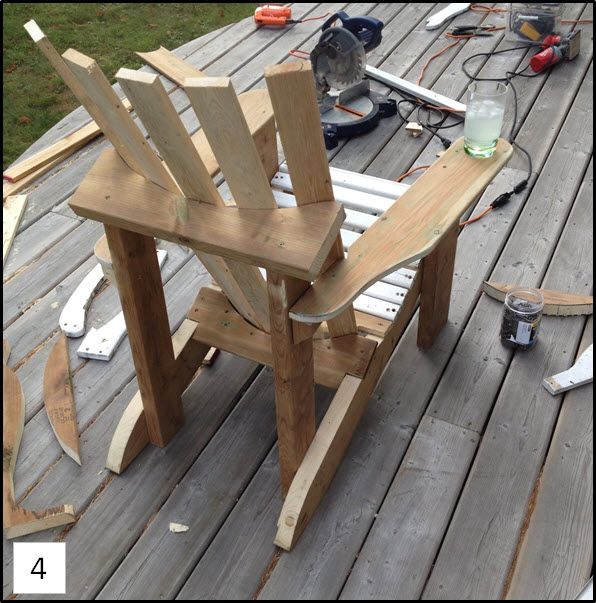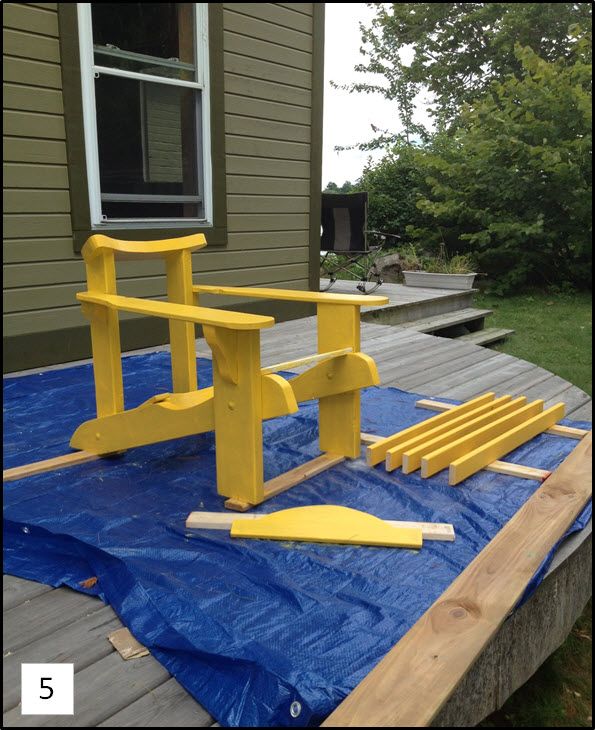Cottage Chairs
by: Tom King
Nothing embodies the art of relaxation more than sliding back into a comfortable, wooden cottage chair, your favourite beverage resting on the wide armrest, and participating in a favourite activity; whether it be it reading a good book, chatting with family and friends, or just watching the world go by.
The Adirondack chair, or Muskoka chair as it is commonly referred to north of the 49th parallel, has been a staple of cottage life for many years and remains as popular as ever. These low-slung lounge chairs were originally made from wood but advances in material science over time has also led to the manufacturing of these pieces of unique furniture from plastic and composite materials. Speaking from personal experience, the quality of the plastic versions ranges from “downright awful” to “top notch”! To the purist, cedar is the preferred material for the construction of the “perfect” chair, but many other species of wood will do the job just fine.
After reviewing several articles on the subject, the consensus is that the roots of the Adirondack chair can be traced back to Westport, New York, a small town located within the bounds of the Adirondack Park. Massachusetts resident Thomas Lee, a summer resident of Westport, wanted to build a wooden chair that wasn’t only comfortable to sit in, but was also stable on the various types of terrain in the area. According to the published works that I read, Mr. Lee developed several different prototypes between 1900 and 1903 before settling on what he considered to be the optimal design. The final rendition incorporated a sloping seat, with the front higher than the rear, a tall, slanted back, and large armrests. In Lee’s original version of the chair the seat and back were made from single pieces of wood.
As the story goes, Mr. Lee gave his hunting friend, Harry Bunnell, the plans for the chair so that he could build them in his carpentry shop. Apparently Bunnell was worried that the winter months were going to be very lean that year so the chair plans from Lee, and the associated work, were a very welcome gift. Mr. Bunnell made a few modifications to Lee’s original pattern and began building them to sell to local residents. The chairs were a huge sales success, so Bunnell filed a patent for the Westport chair, which was granted in July of 1905.

For the next twenty years Harry Bunnell operated a successful chair manufacturing business and each of the Westport chairs that his company produced bore his signature. Today, an original, signed Bunnell Westport chair can fetch several thousand dollars.
The original Lee design, with its’ single piece seat and back, became more and more expensive to build due to the increasing scarcity of large pieces of quality knot-free wood. Several different carpenters began to incorporate their own modifications into the chair’s design and the seats and backs were eventually constructed from multiple slats of wood as opposed to the single planks. In 1938 a patent was issued to Irving Wolpin for a “Lawn-Chair” that pretty much reflects the current design of Adirondack and Muskoka chairs. Irving’s design retained the same basic shape of the original Westport chair, but the slanted back was rounded, and the sloping seat was contoured; improvements which made the chairs much more comfortable to sit in. The newly patented chair also retained the large arm rests that are a hallmark of the traditional cottage chair.

Today’s Adirondack, or Muskoka, chairs come in a wide variety of colours, and some are designed to fold up for more convenient storage. Personalization of the chairs can be done by painting them in the owner’s favourite sports team or corporate colours, and adding the appropriate emblems and insignia. I have even seen chairs with the back slats cut into the shape of a fish head and painted accordingly. I think it is pretty safe to say that these chairs will remain a part of cottage life for a long time to come.
When our family first rented the cottage on Sampson Island many years ago, one of the first things that I looked for on the property were some nice wooden chairs to sit and relax in. Unfortunately, the only one I found was on the wood pile behind the storage shed. It had definitely seen better days and was pretty rotten and rickety. Not to be without a chair to park myself in and view the beautiful surroundings, I decided to disassemble the old one and use it to make templates for a new pair. I managed to scrounge up a fair bit of scrap lumber on the island and made a trip to town to buy the rest of the material that was needed. Because I only had a small chop saw and a jig saw, I couldn’t make tapered cuts for the back slats and opted to go with straight pieces instead. Being an engineer, I just had to beef up some of the structural elements of the chairs so that they were much sturdier than the old one. Assembly of all the pieces was straight forward, as I had taken lots of pictures of the original chair from which the new ones were modeled. Once the spacing for all the seat and back slats was finalized everything was given a couple coats of paint before the final assembly. One chair was painted yellow and the other one red.
The photographs below illustrate the steps taken by the author to build the new chairs; [1] the original chair that was found on the island but was too unstable to use safely, [2] the new pieces that were templated from the original chair, [3] the assembly of the new chair frames, [4] finalizing the spacing of the back and seat slats, [5] painting the various components before final assembly, [6] one of the freshly completed chairs.






The first two new cottage chairs were a big hit with everyone, so it was decided to make another pair for the following year. I took all the templates home with me and cut out the necessary pieces in the workshop. I chose to maintain the same style of back slats on the new ones so that all four chairs were identical. Painting and final assembly of the last two chairs was completed at the island that summer. The two new additions were painted blue and green.

A few months after I had completed the chair project my wife happened to spot a beautiful piece of stained glass at a craft sale on the Gananoque waterfront. It was done by Kingston artist Bonita Bell and featured red, blue and green cottage chairs against a lovely sunset. She managed to get the piece home without my knowledge and gave it to me as a Christmas gift that year. I was absolutely thrilled to receive this stunning piece of artwork and it was proudly hung on our front porch where it catches the afternoon sun and literally glows. Now, every time I come out the front door and see the stained glass cottage chairs, I am reminded of all the wonderful times that we have been fortunate enough to spend in the 1000 Islands.

Picturesque images of traditional cottage chairs have always evoked fond memories of special times that families have enjoyed together at their vacation properties, and I have included a couple that I feel do just that.
The gorgeous header photo was taken by the late Ian Coristine and is titled, “The Dining Room”. This is among my personal favourites of all his works. Ian’s wife, Lyne, kindly granted me permission to use this iconic photograph in the article. It is a little known fact that Ian felt he was partly responsible for the surge in popularity of the brightly coloured chairs now seen throughout the region. In his first book, The 1000 Islands, published in 2002, Ian featured a lovely photograph of his neighbour’s pastel hued chairs sitting on their dock and glowing in the early morning sunlight. Ever since that book was published the number of these colourful chairs at island cottages has really taken off, ostensibly due to the attention garnered by their appearance in Ian’s hardcover treasure.

Another image that captures the essence of the subject matter at hand perfectly, shown below, is a painting by one of my favourite local artists, Michael Ringer. It is very aptly titled, Adirondack Chairs and is from Ringer’s Limited Edition Gicleé River Prints collection. I am very grateful that the artist allowed me to also include this fabulous work of art in the story.

By Tom R. King
Tom King and his wife Marion have lived in Milton, Ontario for the past 37 years, where they both worked and raised their family of three children; Kris, Mike and Becca. Tom has captured the history of the tour boat industry as well as giving us the best spider story in the past 16 years!
Read more articles by Tom King here in our new format for TI Life, and more articles on our old site.






Please click here if you are unable to post your comment.